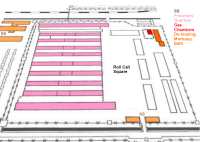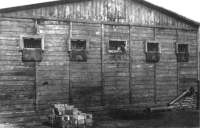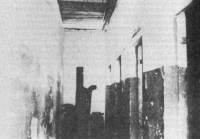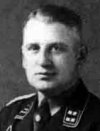 |
| Prisoners' Camp |
The concentration camp Neuengamme was built in
late 1938 30 km east of
Hamburg. Between 40,000 and 55,000 of about 104,000 prisoners who
went through the camp, perished there. Until
early 1940 it was a sub-camp of
KZ Sachsenhausen, then it became an independent KZ.
As in most concentration camps Soviet POWs were imprisoned in Neuengamme; here the commitment of the SS to
extermination was especially aimed at this group of prisoners.
 |
| The "Bunker" #1 |
In Neuengamme two gassings happened, exclusively concerning Soviet POWs. The mass murders took place in
provisional gas chambers within the camp prison, the so-called "
Bunker".
In
Early September 1942, preparations were made in the "
Bunker" to gas the
Soviets with Zyklon B. Pipes were led through the roof, and ventilation fans installed for a quicker spreading
of the gas in the gas chambers. Because the building was rather small (8x6 m) and had only 5 cells and a corridor,
no major reconstruction works were necessary.
The first gassing happened in
September 1942. 197 Soviet soldiers from the POW camp
Stalag XI B in
Fallingbostel
(near
Bergen-Belsen in the Lüneburger Heath) were the victims.
Oddly enough the camp administration didn't try to hide this mass murder; the victims had to assemble on the
roll call square. During the evening roll call they were openly ordered to undress. They were informed that they
were to be disinfected because of the danger of an epidemic in the camp.
Every prisoner was aware of the fate of the Soviets because the nature of the earlier preparations
at the "
Bunker" had already been realized. The prisoners on the roll call square had to listen to the screams
of the incarcerated Soviets after the gas had been released.
According to a witness, the victims took about 10 minutes to die. Then the windows and doors were opened and the corpses
pulled out. Afterwards they were put on carts and brought to the crematory. Only after the corpses were
taken away were the other prisoners allowed to leave the square.
 |
| "Bunker" #2 |
The second and final gassing happened in
November 1942. Now 251 Soviet POWs
(once more from
Fallingbostel) were killed in the same way. This time invalids
were the victims. Those who wore artificial limbs had to remove them. Therefore several invalids had to be
carried by their comrades to the gas chambers.
Again the SS did not try to hide this gassing. Although the entrance door to the "
Bunker" had been
removed from the side facing the roll call square to the opposite side, the prisoners who worked in the bath or the
Revier I (sick quarters) could see everything, and once more the victims had to undress on the roll call square
before being ordered to the gas chambers building.
 |
| Max Pauly |
At the first trial in
Hamburg ("Curiohaus-Trial"
from
18 March until 3 May 1946) of the camp commander
Max Pauly and 13 other SS staff members of KZ Neuengamme
the accused
Bahr, a former medical orderly at Neuengamme, openly talked about
his participation in the killings. Asked by his lawyer about the number of victims of the first gassing
Bahr answered:
"Approximately 180-200."
Lawyer: “Had been certain reconstructions been carried out at the
so-called "
Bunker" in the
autumn of 1942" ?
Accused: “I have surely seen these changes, but I cannot say any more.“
Lawyer: “What were the main changes?“
Accused: “On top of the roof a pipe was installed and a heater with an electrical element was fitted.
I reflected about the reason for this because I didn't know anything about this matter.“
(cited according to
Bringmann)
Later
Bahr stated that he obtained 5 cans of Zyklon B, probably one for each cell.
Then, standing on the roof, and equipped with a gas mask, he took the already opened cans and poured one half of each
can into each of the 5 pipes. After approximately two hours the "
Bunker" was opened and the corpses were
brought to the crematory.
Eleven death penalties were pronounced and executed on
10 October 1946
at the prison in
Hameln. Besides others these SS men were hanged:
Max Pauly, Ewald Jauch, Johann Frahm and the SS physician Dr
Alfred Trzebinski.
Sources:
Kaienburg, Hermann:
Das Konzentrationslager Neuengamme 1938-1945, Gedenkstätte Neuengamme,
Dietz Taschenbuch, Bonn 1997
Bringmann, Fritz:
KZ Neuengamme - Berichte, Erinnerungen, Dokumente, 3. Auflage Frankfurt/M. 1982
Kogon, Eugen u.a.:
Nationalsozialistische Massentötungen durch Giftgas, Frankfurt/M. 1986
Bauche, Ulrich u.a. (Hrsg.):
Arbeit und Vernichtung - Das Konzentrationslager Neuengamme 1938-1945,
2. Auflage, Hambug 1991
Wikipedia
Neuengamme Memorial
© ARC 2006












